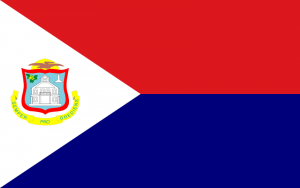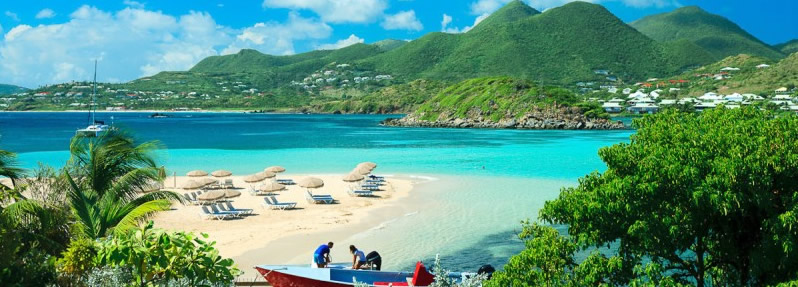Language/French/Culture/St-Martin-Timeline
Jump to navigation
Jump to search
Rate this lesson:
Historical Timeline for St. Martin - A chronology of key events
St. Martin Timeline[edit | edit source]
17th century[edit | edit source]
- From 1624, from the island near Saint-Christophe, the French settled on the east coast of Saint-Martin at a place called "Orléans" to cultivate tobacco. They may come from the 80 French survivors of an expedition to Guyana led by the Lyonnais Henri de Chantail. In 1626, the privateer captain Pierre Belain sieur d'Esnambuc and his Rouen associate Urbain du Roissey, sieur de Chardonville, under the orders of Cardinal Richelieu created the Compagnie de Saint-Christophe in charge of establishing French colonization in this area. The expedition left Le Havre in 1627. Among the crew, figure Claude de Beulayne, later cited as honorable escuyer, sieur de Saint-Martin, captain of militias. He would be the first official commander of the French side.
- In September 1629, following the attack on Saint-Christophe Island by the Spaniards, three weeks after their flight, the French reached Saint-Martin. Roissey bribes one of the captains of the ship there and convinces him to return to France (Cardinal Richelieu has him embastered). In the meantime, Captain Pierre Belain, Sieur d'Esnambuc, disperses his men on Anguilla and Saint-Barthélemy then goes to Antigua where he finds Captain Giron. The latter then went to Saint-Christophe, where the remaining colonists, mostly English, refused him access. Giron then captures two English ships, returns with 350 Frenchmen and re-establishes them on their land without firing a shot.
- In June 1633 a Spanish fleet of 55 ships and 1,300 men attacked the Dutch fort (Fort Amsterdam) built on the Grande-Baie peninsula to the south of the island. They capture the soldiers, disperse the civilians who harvested the salt from the saline and install 250 soldiers and about fifty auxiliaries on this fort which they will reinforce.
- On February 12, 1635, the Company of the American Islands was founded, replacing the previous one. Some French grow tobacco on the eastern part of the island of Saint-Martin despite the presence of a Spanish garrison to the south, in a fort on the site of the so-called Fort Amsterdam. 1648: following the Treaty of Münster (January 1648) the Spaniards dismantle the fort and leave Saint-Martin. On March 23, following a confrontation, Franco-Dutch signing of the Treaty of Concordia which marks the separation of the island between these two nations.
- 1651-1665: The French part of the island of Saint-Martin is under the control of the Hospitallers of the order of Saint-Jean of Jerusalem.
- 1672 to 1679: English temporary occupation (Dutch War).
- 1676, June 22 attack of a Dutch squadron by the beach of Orient Bay, 1,200 soldiers ravage the French part, as they had done in Cayenne and Marie-Galante.
- 1689: the English evacuate the French inhabitants to Saint-Christophe (war of the League of Augsburg).
- 1697 Peace of Ryswick: French inhabitants are allowed to return to Saint-Martin.
18th century[edit | edit source]
- 1703: the governor of Saint-Eustache drives out the French (War of the Spanish Succession).
- 1706: reconquest of the island by a French expeditionary force.
- 1717: following the Treaty of Utrecht (1713), Commander François Lauriol officially takes over the French part of Saint-Martin.
- 1734: in Saint-Martin, Franco-Dutch treaty of neutrality, which displeases the English.
- 1740 to 1748: looting and spoliations by the English. In 1744 during the (War of the Austrian Succession), John Philips, the governor of the Dutch part, betrayed the treaty of 1734 by letting the British troops disembark to attack the French from the rear. All the French population is expelled from the island, it will not return until after the peace following the Treaty of Aix-la-Chapelle (1748).
- 1750: construction of Fort Louis which dominates the village of Marigot and its bay.
- 1756 to 1763: British raids in Anguilla (Seven Years' War).
- 1781 to 1783: British occupation because of the United States War of Independence.
- 1794: British occupation (French Revolutionary War).
- 1796: Victor Hugues arrives from Guadeloupe and drives back the British, including from the Dutch zone. The Commissioner of the Republic Pierre-Charles Dormoy sequesters property belonging to British subjects ... and marries Ann Bayley, the richest landowner.
- 1798-1800: Victor Hugues sets up the Corsairs of the Republic (during the "Quasi-war").
- 1800: the inhabitants surrender to the British (French period of the Consulate).
19th century[edit | edit source]
- 1810 to 1815: British occupation (Napoleonic wars).
- 1816: by the Treaty of Paris, the British surrender the French part of Saint-Martin to French sovereignty. The legal regime applied in Guadeloupe then becomes in theory applicable there.
- A Franco-Dutch convention of November 28, 1839 specifies the application of the Concordia agreements signed in 1648.
- 1848: second official abolition of slavery (but already practically in fact partly French). Mery d'Arcy opens the first industrial salt works in Grand-Case and the Chevrise pond. The following year, Beauperthuy at the Salines d'Orient.
- 1850: faced with the isolation and lack of resources on the island, the Privy Council of Guadeloupe adopts on February 11 a deliberation approving a decree which “grants the dependence of Saint-Martin new commercial immunities, as well as favors news to encourage the exploitation of its salt works ”. Saint-Martin therefore benefits, like Saint-Barthélemy, from a free port status, where customs duties are not collected. With the end of the century, despite quality productions (cattle, cotton, rum, salt), the economy is slumbering more and more. France has always wanted to retain its territorial sovereignty over this small colony but considered it secondary to the other larger French islands in the Antilles. Its insufficient resources are surely the cause.
20th century[edit | edit source]
- The French government loses interest in the colony, except to recover a few soldiers during the two world wars. Many young people go to work in Curacao (oil), the Dominican Republic (sugar cane), the United States Virgin Islands or the United States. Great North American influence.
- From July 1940 to August 1944: the French part of Saint-Martin was under the Vichy regime and led by Governor Constant Sorin in Guadeloupe; the Dutch zone, faithful to Queen Wilhelmina of the Netherlands in exile, is associated with the Allies.
- 1963:
- the island becomes a sub-prefecture.
- start of electrification.
- first banking establishment opened by Crédit Agricole.
- 1965: start of the tourist industry. First desalination plant.
- 1972: opening of Grand-Case airport.
- 1979: first rebroadcast of French television.
- 1981: first landing of the Concorde on the island (at the Juliana aerodrome), come for the promotion of the "Caribbean Port" project in Orient Bay.
- 1983: first impact study on the French part (geographic, historical, sociological, economic, ...), by Yves Monnier (University Paris-XII).
- 198? : last voyage of the mixed ship (cargo / passenger) the Delgrès between Saint-Martin (Marigot) and Guadeloupe (Pointe-à-Pitre).
- 1986: tax exemption law known as the Pons law (economic development). First local radio show.
- 1989, December 16: meeting of French presidents François Mitterrand and American presidents George H. W. Bush, at Anse-Marcel.
- 1991: economic depression during the Gulf War.
- 1994: first historical study published about the sugar houses of Saint-Martin, by Parisis Denise & Henri.
- 1995, September 5: devastation by the Luis and reconstruction.
- 1998, September 3: national decree creating the Saint-Martin marine nature reserve.
21st century[edit | edit source]
- 2002, January 1: introduction of the euro, followed by the gradual abandonment of the French franc (FF).
- 2003: economic depression with the Iraq war.
- During the referendum of December 7, 2003, with a participation rate of 44.18%, 76.17% of the votes cast voted in favor of the change of status authorized by article 74 of the French constitution, which provides for the development from the municipality to an overseas collectivity.
- 2007, February 7: the organic law creating the new community is adopted by the French Parliament (law no 2007-223 of 02/21/2007).
- 2008, September 21: election of the first senator representing the French part of Saint-Martin. Louis-Constant Fleming is elected by large voters by 17 votes out of 24.
- 2010, October 10: The State of the Netherlands Antilles is officially dissolved and Saint-Martin becomes an autonomous state of the Kingdom of the Netherlands just like Curaçao.
- 2012, June 10 and 17: election of Daniel Gibbs, first French deputy representing Saint-Martin and Saint-Barthélemy.
- 2014, night of October 13 to 14: passage of hurricane Gonzalo (Category 1).
- 2015, May 8: protocol visit of a few hours by President François Hollande.
- 2017, September 6: Saint-Martin is devastated by Hurricane Irma, one of the most powerful ever recorded in the North Atlantic, with the eye (50 km in diameter) which encompasses for about an hour the entire of the island.
Sources[edit | edit source]
World Timelines[edit source]
Other Lessons[edit | edit source]
- Les clichés
- French meals
- Gabon Timeline
- Vaincre ou Mourir
- Congo–Brazzaville Timeline
- Why Learn French
- French Southern Territories Timeline
- Funny idiomatic expressions
- Clipperton Island Timeline


